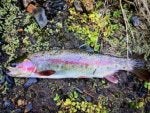neilstallings
New member
Hey everyone!
Last summer I backpacked to an alpine lake in Western Washington and caught several fish. Elevation was 3800' and the lake was fairly small with snow runoff nearly year round. I caught two or three typical rainbows (picture included), but what really made me scratch my head was one that I assumed to be a cutthroat at first glance. It was a female and has the red gill plate, but no slash under the jaw. What really interested me was the DARK red fins with slightly white edges (but not on the dorsal or pectorals). She seemed to be an old timer based on the wear and tear on her fins and seemed to be losing scales sadly. Released her right away after snapping this picture, but the longer it's been since then, the more I wonder what she was.
I know there are cases of trout cross-breeding (Tiger Trout), especially in small lakes with little contact and it becomes their only option for survival, but I'm not finding any pictures like this anywhere online. Thanks for your help identifying this beauty!

Last summer I backpacked to an alpine lake in Western Washington and caught several fish. Elevation was 3800' and the lake was fairly small with snow runoff nearly year round. I caught two or three typical rainbows (picture included), but what really made me scratch my head was one that I assumed to be a cutthroat at first glance. It was a female and has the red gill plate, but no slash under the jaw. What really interested me was the DARK red fins with slightly white edges (but not on the dorsal or pectorals). She seemed to be an old timer based on the wear and tear on her fins and seemed to be losing scales sadly. Released her right away after snapping this picture, but the longer it's been since then, the more I wonder what she was.
I know there are cases of trout cross-breeding (Tiger Trout), especially in small lakes with little contact and it becomes their only option for survival, but I'm not finding any pictures like this anywhere online. Thanks for your help identifying this beauty!








